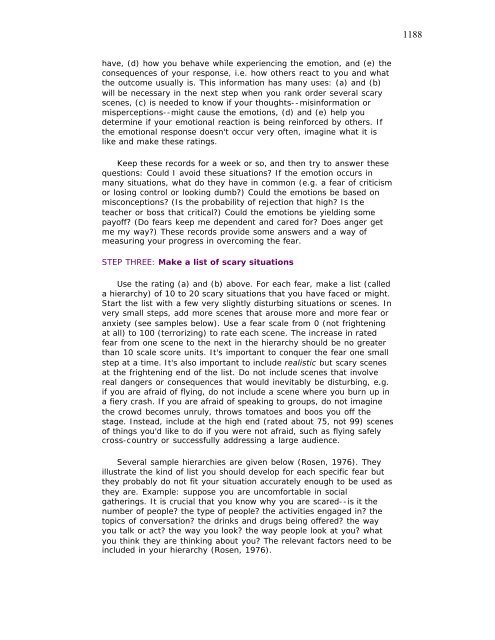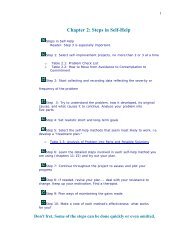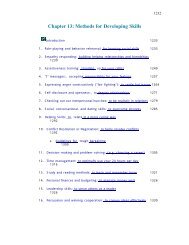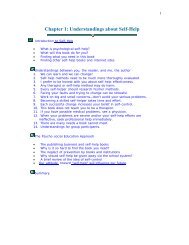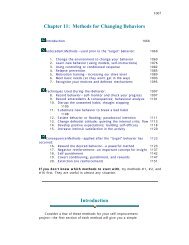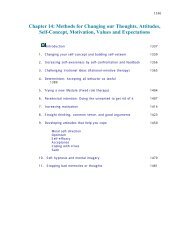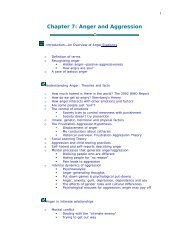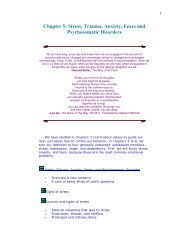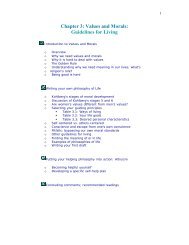Chapter 12: Methods for Changing Emotions - Psychological Self-Help
Chapter 12: Methods for Changing Emotions - Psychological Self-Help
Chapter 12: Methods for Changing Emotions - Psychological Self-Help
Create successful ePaper yourself
Turn your PDF publications into a flip-book with our unique Google optimized e-Paper software.
1188<br />
have, (d) how you behave while experiencing the emotion, and (e) the<br />
consequences of your response, i.e. how others react to you and what<br />
the outcome usually is. This in<strong>for</strong>mation has many uses: (a) and (b)<br />
will be necessary in the next step when you rank order several scary<br />
scenes, (c) is needed to know if your thoughts--misin<strong>for</strong>mation or<br />
misperceptions--might cause the emotions, (d) and (e) help you<br />
determine if your emotional reaction is being rein<strong>for</strong>ced by others. If<br />
the emotional response doesn't occur very often, imagine what it is<br />
like and make these ratings.<br />
Keep these records <strong>for</strong> a week or so, and then try to answer these<br />
questions: Could I avoid these situations? If the emotion occurs in<br />
many situations, what do they have in common (e.g. a fear of criticism<br />
or losing control or looking dumb?) Could the emotions be based on<br />
misconceptions? (Is the probability of rejection that high? Is the<br />
teacher or boss that critical?) Could the emotions be yielding some<br />
payoff? (Do fears keep me dependent and cared <strong>for</strong>? Does anger get<br />
me my way?) These records provide some answers and a way of<br />
measuring your progress in overcoming the fear.<br />
STEP THREE: Make a list of scary situations<br />
Use the rating (a) and (b) above. For each fear, make a list (called<br />
a hierarchy) of 10 to 20 scary situations that you have faced or might.<br />
Start the list with a few very slightly disturbing situations or scenes. In<br />
very small steps, add more scenes that arouse more and more fear or<br />
anxiety (see samples below). Use a fear scale from 0 (not frightening<br />
at all) to 100 (terrorizing) to rate each scene. The increase in rated<br />
fear from one scene to the next in the hierarchy should be no greater<br />
than 10 scale score units. It's important to conquer the fear one small<br />
step at a time. It's also important to include realistic but scary scenes<br />
at the frightening end of the list. Do not include scenes that involve<br />
real dangers or consequences that would inevitably be disturbing, e.g.<br />
if you are afraid of flying, do not include a scene where you burn up in<br />
a fiery crash. If you are afraid of speaking to groups, do not imagine<br />
the crowd becomes unruly, throws tomatoes and boos you off the<br />
stage. Instead, include at the high end (rated about 75, not 99) scenes<br />
of things you'd like to do if you were not afraid, such as flying safely<br />
cross-country or successfully addressing a large audience.<br />
Several sample hierarchies are given below (Rosen, 1976). They<br />
illustrate the kind of list you should develop <strong>for</strong> each specific fear but<br />
they probably do not fit your situation accurately enough to be used as<br />
they are. Example: suppose you are uncom<strong>for</strong>table in social<br />
gatherings. It is crucial that you know why you are scared--is it the<br />
number of people? the type of people? the activities engaged in? the<br />
topics of conversation? the drinks and drugs being offered? the way<br />
you talk or act? the way you look? the way people look at you? what<br />
you think they are thinking about you? The relevant factors need to be<br />
included in your hierarchy (Rosen, 1976).


